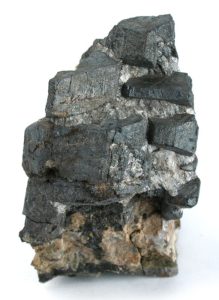
What is it? Lithiophilite, LiMnPO4
What’s it made of? Lithium (Li), manganese (Mn), phosphorus (P) and oxygen (O). The PO4 at the end of the formula makes this a phosphate mineral (phosphorus + oxygen = phosphate).
What’s it’s structure? The way the different atoms are arranged in lithiophilite is described as orthorhombic, which means the crystal is built of lots of tiny cuboid-shaped atomic meshes (we call these individual building blocks unit cells). The mineral olivine, which makes up most of the top 440 km of the Earth, is also orthorhombic (shout out to olivine-my favourite mineral-which unfortunately is far too common for #mineralmonday).
Is it useful? Not directly. It’s far too rare to mine for lithium, the useful part of the mineral. But, if we swap out the manganese (Mn) for iron (Fe), we get another mineral called triphylite (LiFePO4), which can be grown in the lab, and is a battery material with some potential applications in electric cars and bikes.
How can a crystal be a battery? A battery is basically just a material that can provide a flow of electrons. This means that something in the battery needs to oxidise (oxidation means loss of electrons, and a gain of positive charge). The iron in the LiFePO4 can oxidise, similar to how pieces of iron will rust (oxidise) over time. It’s basically the lithium, which can move around in, and out of, the mineral, that makes this possible.
What is it named after? It’s a mineral that really really likes lithium, so I guess we could describe it as a lithiophile (filos, filia etc. being Greek for friend). So it’s a friend of lithium, which is convenient because it’s made of it. Just to keep things confusing, we also have the word ‘lithophile‘ in geology, which more or less means an element that concentrates in the rocks we find on the Earth’s surface (lithos = stone, in Greek again). And to round it off, the element lithium was also named after lithos, because it was originally found in rocks.
It seems like they could have used another word. But at least lithium and lithiophilite were both discovered in Greece, right? That would make sense… But no, lithium was discovered in Sweden and lithiophilite in the USA. But, they were both found in the 1800s before thesaurus.com, so let’s not be judgemental…
Do you have a favourite obscure mineral? Want to write about it? Contact us and give it a go!


